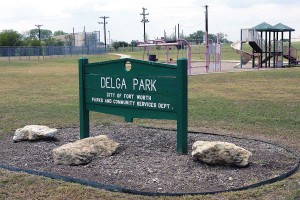Epstein has been studying the health effects from oil and gas exposure as part of her work with Lubbock’s Board of Health, which advises the city on public health risks.
“Long-term negative exposure to benzene at seven times the long-term limits is certainly a … threat to health,” she said. “This is definitely a cancer-causing agent. It causes leukemia and aplastic anemia, a low red blood count that is very dangerous to humans.”
Benzene suppresses the formation of blood cells in the bone marrow, she said. If ShaleTest’s single-day air-collection samples from the playgrounds were shown to be typical, Epstein said, that would represent a significant health risk.
“It’s important to remember that the acceptable toxicity levels for these chemicals were set for adults, not children,” she said. “Children and pregnant women are more susceptible to a variety of health risks from chemicals in the air, especially during critical windows of development when children’s brains and internal organs are growing rapidly.”
The presence of multiple chemicals complicates the picture, she said, but high levels of benzene “is the big red flag for me.”

Chesapeake spokesman Gordon Pennoyer said he would look into the question of the company’s compressor station near Delga Park but had not provided any response by press time.
Tim Ruggiero, a partner with Tillman in ShaleTest, said Chesapeake’s failure to respond didn’t surprise him.
“It frustrates me how these companies can avoid responding to things that might cast them in a negative light,” he said. “Take the FLIR camera: Whenever we show videos of the huge plumes, sometimes two miles long, coming off a compressor station, the typical response to reporters is, at best, a comment that what our camera was picking up was heat, not gas. That’s just not true: We’re using an $85,000 FLIR camera, and we’re picking up gas with it.”
Along one side of Delga Park is a row of about a dozen small, neat, single-family homes. Ruggiero said he’s talked to three of the homeowners.
“There’s one woman in that row who can’t hold down a job because she’s always sick, and none of the doctors she’s seen can explain why she has rashes and is constantly nauseated. Another woman has a child whose hair is falling out, and the doctors can’t give her any explanation about why that is happening.”
Ruggiero said he’s surprised that people, especially doctors, are not connecting the dots between the symptoms and the cause. “If people living near these gas facilities are all coming down with similar symptoms — rashes, nausea, eye problems, nerve issues — well, I think you ought to look to see if there is a connection between those facilities and those symptoms.”
Dr. Carol Kwiatkowski is executive director of The Endocrine Disruption Exchange, a nonprofit organization dedicated to collecting scientific information on health and environmental problems caused by low-level exposure to chemicals that interfere with human development and function. She said it’s not easy to show the connection Ruggiero talked about.
The link between combinations of dangerous chemicals and chronic health problems “has simply not been studied enough, something our organization is trying to rectify,” she said. “But there is definitely potential for impacts to kids.

“Benzene we know about, but toluene and methylene chloride — these are other chemicals that are not good to have around humans,” she said. What scientists are seeing in their studies, she said, is that even in low doses, aggregates of such chemicals “are causing asthma, respiratory effects, and immune-system compromising. And children are so much more vulnerable than adults. Their bodies are not capable of dealing with them. The last thing you would want to do is put a playground anywhere near things like a compressor station.”
Jim Schermbeck, a longtime activist and director of the grassroots environmental group Downwinders At Risk, has been studying the issue for years. He agreed with Kwiatkowski’s assessment.
“Those VOCs stay close to the ground, congregating exactly where kids are going to be playing. And we know from studies that have been done in Texas and other states that the more time you spend around a compressor station or a leaking tank, the more danger you are putting yourself in,” he said. “And it’s particularly insidious to put parks where children are playing near these facilities.”
That’s exactly what was done in DISH. Several companies built compressor stations and other gas facilities just outside of the town limits beginning in 2006. To show what good neighbors they were, the companies provided most of the funding for a large playground 300 feet from a well site and less than 700 feet from one of the largest compressor station complexes in Texas.
Many dozens of people in DISH began coming down with a wide variety of illnesses, from neurotoxicity to nosebleeds. Tillman, elected mayor of DISH in 2007, tried to fight the gas companies but had little success because the facilities were outside his town’s limits. When his own sons began having regular nosebleeds, he decided to leave.
“We were the epicenter of the Barnett Shale boom, and it was just awful,” he said.
The compressor stations there have since been enclosed, and other efforts have been made to lower toxins in the air. But when ShaleTest performed an ambient air- quality study there for Project Playground in late October 2012, both benzene and xylene were still found at levels above TCEQ’s recommended limits. A long list of other poisonous chemicals, similar to the chemical soup found at Delga Park, was also detected.
David Sterling, a professor of environmental and occupational health at UNT’s Center for BioHealth, declined to comment on the ShaleTest study because he had not seen it. But he agreed with other scientists that if benzene in high levels was found at a playground and there was no other source that might have been causing it, “steps should be taken to reduce or eliminate the releases.”
Sterling noted that “a park near a busy road is going to have many of the same results … from automobile exhaust.” But he acknowledged that the volume of benzene found at Delga Park — 10 parts per billion — was very high.
Tillman doesn’t buy into the possibility that traffic exhaust could cause the levels of benzene and xylene found at several of the parks. “I’ve been told that you might get a reading of 1 part per billion for benzene from a busy road. In DISH we had nearly three parts; in Delga Park we had 10. There’s no way you could get those readings from traffic.”
In collecting air samples at Delga, he said, “We walked as close to the gas facility as we could. We had the FLIR so we could see the gas plume, and we walked right into it to get our reading. It wasn’t from traffic.”
********











TCEQ and critics will likely dispute this study – When they do – feel free to post their own investigation conducted at the same Mansfield location where they did detect Benzine, Toluene, Ethylebenzene, Chloroform and a long list of other toxins – Download the TCEQ Huston report here – http://mansfieldgaswellawareness.weebly.com/documentation .. ( tceq_violation_huston_1134156.pdf ) and the FLIR from this investigation is on the home page. This was during school hours and my son was in the Daycare/Playground that day 900 ft down wind from the event .
My husband’s co-worker and his family live in the neighborhood beside Delga Park. He has 2 or 3 small children. His young wife was recently diagnosed with Leukemia.
Great read, Peter. Thank you for your dedication to our communities.
The UTA Air monitor is getting benzene spikes too above the long term exposure threshold, but ANY amount of Benzene is unhealthy…
http://barnettshalehell.wordpress.com/2012/11/01/benzene-over-5-times-background-utarlington-air-monitor-last-night/
The FORT WORTH WEEKLY is a local left-leaning free tabloid. It has published anti-fracking articles for as long as natural gas drillers have been fracking for gas in Texas. In its most recent issue, writer Peter Gorman condemns the natural gas industry for creating toxicity at Fort Worth’s Delga Park. https://www.fwweekly.com/2014/10/01/bad-air-day/.
Gorman’s article is replete with jargon about acceptable readings for benzene, xylene, toluene, and the like. This is so over my head that I won’t endeavor to challenge it. But Gorman went further: He said that after 30 minutes in Delga Park, he felt searing in his throat. After an hour, his eyes watered. In two hours, breathing was difficult even though he was sedentary, and he had to leave.
I doubted his story. Look: There are folks who oppose the harvesting of fossil fuels AT ALL, and I think Fort Worth Weekly is in that crowd. You publish a tabloid which regularly condemns fracking; then you publish an article where the writer says a gas well caused his shortness of breath; and I’m going to question his agenda.
So this morning, armed with a croissant, coffee, and the Sunday crossword, I went to Delga Park to replicate Gorman’s experience. The place does have a distinctive smell. But so do my feet, and it doesn’t make them deadly. After 30 minutes, my only sensation was that the croissant and coffee had done their work and I looked around for a portapotty. Bored with the puzzle, I began walking around the park. I walked through the ball field, then to the natural-gas plant so I get a selfie of me and a pipeline-warning sign. Every now and then I sat to work on the puzzle, but the majority of my two hours at Delga Park was spent walking.
I found out what I wanted to know. In Gorman’s two hours there, he claims he experienced a burning throat; watery eyes; and shortness of breath without physical exertion. I’m on the downhill side of 60, and I experienced none of this. Gorman is either a liar or a wuss.
I recommend you walk there everyday for at least two hours. That is the best way to counter this story.
So based on your individual experience, you’re okay with this toxic emissions plant right next to homes and a playground? What may also be ‘over your head’, in addition to the actual testing results, is that everyone has different tolerances and chemical sensitivities. Also, many of the emissions have no odors. That’s why the FLIR footage is important, to show these emissions that are not visible with the naked eye-and some the nose.
You are correct on so many levels. This newspaper is against drilling and oil and gas production but they continue to drive vehicles, heat their homes and offices with natural gas, and use electricity derived from coal (I’d bet good money on it)
The saving grace is that very few read this publication. Same as radio – liberal radio shows, TV shows and print publications fare far worse than their conservative counterparts.
Wait…you actually think it would be a good thing if very few people read a publication with award-winning investigative features and edited by a Pulitzer Prize winner?
Be gone, troll.
Ruggiero: Natural gas is potentially lethal and we know going in that there are inherent risks with it. Indeed, there are risks inherent with almost all forms of energy. I do not favor banning gas plants that are “right next to homes and a playground” merely because there’s SOME level of toxicity. If we were to take such a zero-tolerance approach, we would end up banning many quite useful things.
There should be objective standards for energy producers, and citizens should insist that regulators hold energy producers to them. But that’s the part of Gorman’s article that I did not challenge because I can’t. His scientific data will stand or fall on its own.
The point is that Gorman should have stuck to such data and avoided the dramatics of him leaving the park gasping for breath. His article declaimed the park’s hazards to children and pregnant women, but the best example he could cite was shortness of breath by a 60ish man who smokes? (See Gorman’s website photos).
I think you miss the point. There are less than a dozen families living in nice little houses that abut the park. One woman can no longer work because of constant rashes and nausea that started after the compressor stations came in. One woman has leukemia, which occurred after the compressor stations came in. One woman has a child who is losing his hair, a condition that began after the compressor stations came in. All of these conditions occur with exposure to the chemicals found in the “air grabs”. That’s three out of 10-11. Is that acceptable to you, or anyone? Is is acceptable when you can fix it so that there is no gas escaping at nearly no cost? Is it acceptable if you were a shareholder or a lease owner to know that 25 percent of the gas coming from the wells is escaping into the air, poisoning people and costing you 25 percent of your royalty? I don’t know. I don’t think, like either you or the person who posted prior to you, that anyone at the FW Weekly is against energy. I think that everyone who knows the score is against bad business practices that hurt people/sometimes kill people. Of course the gas industry resists change that would fix the problems: Most of us resist change because we’re comfortable with the way we do things and change suggests that we’ll have to, well, change….and that is not attractive. It’s downright scary. But it is very doable. It doesn’t cost a lot of money, just a small infusion that quickly pays for itself and subsequently makes a profit for everyone and prevents more leukemia/hair falling out/rash problems and so forth. And yes, I drive a car: A Ranger, actually, and I heat my house with electricity which is possibly powered by coal or gas or oil. The problem isn’t always the product, the problem is sometimes the hands in which the product lies. If the gas companies wanted to be good neighbors, gas drilling would quickly disappear from our pages–which are actually read by tens of thousand of people and make changes in places like New York, which banned drilling because of our stories, among others. But if energy companies insist on doing the shoddiest work, cutting corners, ignoring and then denying illnesses they cause, well, as good citizens, we’ll probably keep calling them out on it.
And yes, I’m a 63-year-old cigarette smoker. I still walk several miles a day, take four groups a year out into the deep Amazon jungle and can certainly out push-up most men my age. And no, I’m not a liar regarding what happened that day in Delga Park. Which leaves me, I guess, just a wuss. Darn it!
These gas-driller apologists missed your point, Mr. Gorman. The Startle-Gram hacks and tea- bagging nit-wits go into their act every week on the Weekly’s pages. Don’t you know their mamas are proud of them? They’re the heroes who gave us Dick Cheney & the Bushes and helped shut down our country’s economy, so that our our nation could neither pay it’s bills nor fulfill it’s promises. To answer my own query – yes, their tea-bagger mamas ARE proud of them!
Texans don’t give a shit whether the natural gas business is endangering Texans.
Have you seen all the oil and gas wells in our neighborhoods? Texans, being predominately white Republicans, love ‘big bidness’ like gas and oil. They care about their drilling jobs and their gas royalties. The all mighty dollar rules conservatives. They hate the EPA. They treat environmentalism as if it were spawned by a Kenyan Islamo-terrorist with bad acne and a crack habit.
And as far as protecting Texas children is concerned, Texans do not care enough about their children to teach them REAL science and REAL history. They would rather indoctrinate their children in religious fairy tale nonsense or revisionist, right wing claptrap like “American Exceptionalism.’
There is a very good reason why big oil and big business loves Texas, but we are too intoxicated by the green of money to give a shit about any other type of ‘green.’